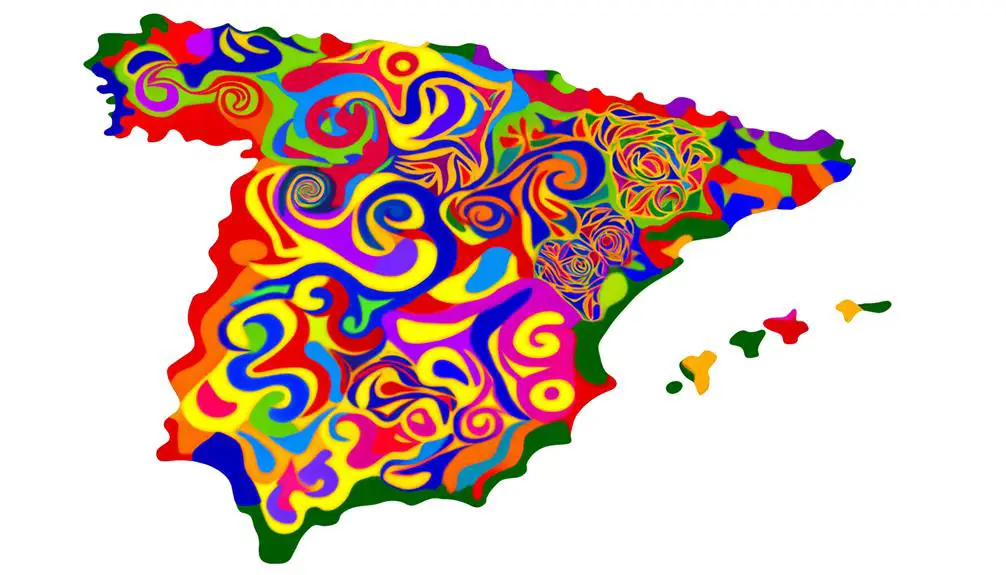When you use 'pronto' in Spanish slang, you're not just saying 'soon' or 'quickly'. You're buying time, expressing enthusiasm, or softening the tone of a conversation. 'Pronto' implies prioritization, urgency, and commitment, carrying cultural nuances that aid effective communication. You can use it to brush off commitments or convey excitement. However, regional variations influence its meaning, and mastery requires understanding these subtleties. As you navigate the complexities of 'pronto', you'll uncover its full potential, and your everyday conversations will take on a new level of fluency and authenticity, opening the door to deeper connections and cultural understanding.
Pronto in Everyday Conversations

When chatting with Spanish-speaking friends, you'll often hear 'pronto' sprinkled throughout everyday conversations, serving as a versatile expression that can convey a range of meanings beyond its literal translation of 'soon' or 'early'.
This phrase has become an integral part of conversational flow, allowing speakers to navigate various social situations with ease. In practical applications, 'pronto' can be used to buy time, express enthusiasm, or even soften the tone of a conversation.
For instance, when asked about meeting up, you might respond with 'pronto' to indicate that you'll get back to the person soon, without committing to a specific time. This flexibility makes 'pronto' an indispensable tool in everyday conversations, enabling speakers to adapt to different contexts and relationships.
Meaning Beyond 'Soon' or 'Quickly'
How do you typically respond when someone asks about a task's status, and you're still working on it? You might say 'pronto' to convey that you're close to finishing, but what if you're not? This is where the nuances of pronto idioms come into play.
In Spanish slang, pronto can mean more than just 'soon' or 'quickly.' It can also imply a sense of prioritization or urgency.
For instance, if someone asks when you'll finish a project, saying 'pronto' might imply that you're making it a priority, even if it takes a few days. This Pronto irony is rooted in the cultural context, where time is often viewed as a flexible concept.
So, when you say 'pronto,' you're not just giving a timeline, but also conveying a sense of commitment to getting it done.
In everyday conversations, pronto idioms can help you navigate these subtleties. By understanding the context and cultural nuances behind the word, you can communicate more effectively and avoid misunderstandings.
Casual Dismissal and Brush-Offs

You've likely encountered situations where someone asks you to commit to a task or favor, and you respond with 'pronto' to brush them off or dismiss the request. In Spanish slang, using 'pronto' in this context is a clever way to sidestep commitments without directly saying no. This casual dismissal is often accompanied by a tone that implies you'll get to it eventually, but in reality, you have no intention of following through.
When you respond with 'pronto', you're implying that you'll take care of it soon, but the reality is that it mightn't happen at all. This tactic is often used to avoid direct confrontation or to buy time. It's a polite way of saying no without actually saying no. Be cautious, though, as overusing this tactic can come across as insincere or even sarcastic. Casual excuses and sarcastic responses can be detected, and they may damage your credibility.
In essence, using 'pronto' as a brush-off is a common practice in Spanish-speaking cultures. However, it's essential to be mindful of your tone and the frequency of using this tactic to avoid being perceived as insincere or unreliable.
Expressing Enthusiasm and Agreement
In contrast to using 'pronto' as a polite way to dismiss requests, this versatile phrase can also convey enthusiasm and agreement, as you'll often respond with 'pronto' to express excitement or confirm a plan. This phrase is particularly useful when you want to show keenness and assurance, making it a valuable tool in your Spanish slang arsenal.
Here's how you can use 'pronto' to express excitement and agreement:
| Situation | Response |
|---|---|
| Friend invites you to a party | ¡Pronto! (I'm in!) |
| Colleague suggests a meeting time | Pronto, ¡allí estaré! (Great, I'll be there!) |
| Family member asks for help | ¡Pronto, cómo puedo ayudar! (Of course, how can I help?) |
Regional Variations and Nuances

Across Latin American countries and regions, being mindful is crucial when it comes to understanding the different flavors of pronto, as well as the varying nuances and connotations that can have a significant impact on the tone and reception of your message.
You'll notice that dialectical differences shape the way pronto is used in different regions. For instance, in some countries, pronto implies a sense of urgency, while in others, it's more casual and relaxed. Geographical influences also play a significant role in shaping the connotations of pronto.
Coastal regions, for example, might use pronto to convey a sense of laid-backness, whereas inland regions might use it to convey a sense of promptness.
When communicating with people from different regions, being aware of these regional variations is crucial. Misusing pronto can lead to misunderstandings or unintended tone. You should consider the cultural context and dialectical differences to make sure that your message is conveyed effectively.
Pronto in Mexican Slang Culture
Mexico's unique cultural landscape has shaped the use of 'pronto' in its slang culture, where the word has taken on a distinct flavor that reflects the country's vibrant history and regional diversity. As you explore the cultural significance of 'pronto', you'll discover that its evolution is deeply rooted in Mexico's complex history. The word has absorbed the influences of indigenous, European, and African cultures, giving it a unique flavor that's distinct from its Spanish counterpart.
In Mexican slang culture, 'pronto' has become a term that's intertwined into everyday conversations, often used to convey a sense of urgency or immediacy. But beyond its literal meaning, 'pronto' carries a cultural significance that mirrors Mexico's history of colonization, revolution, and modernization.
Using Pronto With Friends and Strangers

When interacting with friends, you'll often find yourself using 'pronto' to make plans or request something urgently, while with strangers, the tone and context of the conversation dictate how and when to deploy this versatile word.
With friends, you can use 'pronto' in a more casual and relaxed manner, as you're within established formal boundaries. You might say, 'Vamos al cine pronto' (Let's go to the movies soon), and your friend will understand the urgency and informality of the situation.
However, when interacting with strangers, you need to be more mindful of cultural norms and formal boundaries. You might use 'pronto' in a more formal tone, such as 'Necesito que lo hagas pronto' (I need you to do it soon), to convey a sense of urgency while still maintaining a level of respect.
In both cases, understanding the context and tone of the conversation is critical to using 'pronto' effectively. By being aware of these nuances, you can navigate different social situations with confidence and precision.
Tone and Context Matter Most
In Spanish conversations, your tone and context serve as the ultimate arbiters of 'pronto's meaning, and understanding their nuances is essential to conveying the intended sense of urgency or haste. When you say 'pronto' with a relaxed tone, you're implying a casual, non-pressing deadline. Conversely, a more urgent tone conveys a greater sense of immediacy.
The cultural implications of tone and context are significant, as misinterpreting them can lead to misunderstandings. For instance, in some Latin American countries, using 'pronto' with a stern tone can come across as aggressive or demanding.
Emotional inflections also play a critical role in conveying the intended meaning. A gentle, encouraging tone can soften the sense of urgency, while a more forceful tone can amplify it. You must consider the emotional context in which you're using 'pronto.' Are you reassuring someone that help is on the way, or are you urging them to take immediate action?
Mastering Pronto in Everyday Speech

To integrate 'pronto' seamlessly into your everyday speech, you'll need to develop a keen sense of its nuances and practice using it in various conversational scenarios. This involves recognizing the Pronto pitfalls that can lead to miscommunication, such as using it as a direct translation of 'soon' in English. Instead, you should focus on understanding the subtle distinctions between 'pronto' and other time-related expressions in Spanish.
As you master the subtleties of 'pronto,' you'll notice a Pronto evolution in your language skills. You'll be able to convey a sense of urgency or proximity with precision, whether you're discussing a deadline, a meeting, or a casual gathering.
To take your skills to the next level, try incorporating 'pronto' into conversations about future plans, appointments, or schedules. With practice, you'll develop a natural flow and rhythm that will make you sound like a native Spanish speaker.
Frequently Asked Questions
Can I Use "Pronto" in Formal Writing and Business Emails?
When writing formal emails or business correspondence, you're better off avoiding 'pronto' to maintain a professional tone.
While it's a common Spanish word for 'soon,' it may come across as informal in formal writing.
Instead, opt for more formal expressions like 'en breve' or 'dentro de poco tiempo' to convey a sense of urgency without compromising your professional image.
Is "Pronto" Only Used in Informal Settings and Casual Conversations?
As you navigate the labyrinth of language, you'll find that 'pronto' isn't exclusively reserved for casual conversations. While it's true that 'pronto' is often used in informal settings, it's not entirely absent from formal contexts.
Regional nuances and cultural implications play a significant role in its usage. In some Latin American countries, 'pronto' is commonly used in business emails, whereas in others, it's viewed as too colloquial. You'll need to take into account these factors to decide when to deploy 'pronto' effectively.
Can Non-Native Speakers Use "Pronto" Without Sounding Unnatural?
When using colloquial expressions, you may wonder if you'll sound unnatural. The truth is, cultural nuances can be tricky to navigate. As a non-native speaker, you might struggle to use 'pronto' authentically.
Language barriers can make it difficult to grasp the subtleties of informal language. However, with practice and exposure, you can master the nuances and use 'pronto' confidently, blending in with native speakers.
Does "Pronto" Have a Direct English Translation or Equivalent?
You're wondering if 'pronto' has a direct English translation or equivalent. In a literal sense, 'pronto' translates to 'soon' or 'quickly,' but its usage is more nuanced.
In marketing, 'pronto' conveys a sense of urgency, while in subtitles, it's often translated as 'right away' or 'immediately' to preserve the original tone.
While there isn't a single direct equivalent, 'pronto' can be adapted to convey a sense of promptness or swiftness in various contexts.
Is "Pronto" Commonly Used in Other Latin American Countries?
You're wondering if 'pronto' is commonly used in other Latin American countries. While it's widely used in Spain, its usage varies across Latin America due to regional variations and country-specific nuances.
In Mexico, for instance, 'pronto' is less common, whereas in Argentina, it's frequently used in informal settings. In Chile, it's often replaced with 'ahora' or 'en seguida'.
You'll find that each country has its own distinct way of expressing 'soon', reflecting local cultural and linguistic traits.







